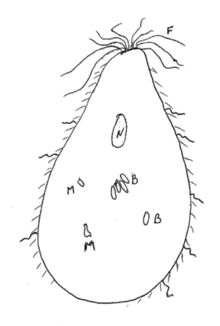Mixotricha paradoxa
| Mixotricha paradoxa | |
|---|---|

| |
| Klasifikasi ilmiah | |
| Domain: | |
| Kerajaan: | |
| Filum: | |
| Kelas: | |
| Ordo: | |
| Famili: | |
| Genus: | |
| Spesies: | M. paradoxa
|
| Nama binomial | |
| Mixotricha paradoxa Sutherland, 1933
| |
Mixotricha paradoxa adalah spesies protozoa yang hidup di dalam usus rayap Mastotermes darwiniensis[1] dan memiliki beberapa simbion bakteri.[2] Spesies ini dinamai dan pertama kali dideskripsikan pada tahun 1933 oleh biolog Australia J.L. Sutherland.[3][4]
Simbiosis
Mixotricha memiliki hubungan simbiosis mutualisme dengan rayap Mastotermes darwiniensis. Spesies ini hidup di usus rayap tersebut dan membantu mereka mencerna selulosa, komponen penting dalam kayu. Tanpa Mixotricha, rayap inangnya tak akan mampu bertahan.
Mixotricha juga memiliki hubungan mutualistik dengan bakteri. Spesies ini punya empat flagella di depan, namun flagella tidak digunakan untuk bergerak, tetapi untuk menyetir. Untuk bergerak, sekitar 250.000 bakteri Treponema spirochetes yang terpasang di permukaan sel "menarik" Mixotricha sehingga seolah bergerak dengan cilia. Selain itu, di dalam sel terdapat bakteri berbentuk bola yang berfungsi sebagai mitokondria yang tak dimiliki Mixotricha.
Genom
Menurut Margulis dan Sagan (2001), Mixotricha punya lima genom karena memiliki hubungan simbiosis yang dekat dengan empat bakteri.[5]
Referensi
- ^ Radek R, Nitsch G (2007). "Ectobiotic spirochetes of flagellates from the termite Mastotermes darwiniensis: attachment and cyst formation". Eur. J. Protistol. 43 (4): 281–94. doi:10.1016/j.ejop.2007.06.004. PMID 17764914.
- ^ Brugerolle G (2004). "Devescovinid features, a remarkable surface cytoskeleton, and epibiotic bacteria revisited in Mixotricha paradoxa, a parabasalid flagellate". Protoplasma. 224 (1–2): 49–59. PMID 15726809.
- ^ Jean L. Sutherland: Protozoa from Australian Termites. Quarterly Journal of Microscopical Science, Band s2-76, S. 145-173. (Abstract)
- ^ L. R. Cleveland, A. V. Grimstone: The Fine Structure of the Flagellate Mixotricha paradoxa and Its Associated Micro-Organisms. Proceedings of the Royal Society of London. Series B, Biological Sciences, Band 159, 1964, S. 668-686. doi:10.1098/rspb.1964.0025
- ^ Margulis, Lynn (2001). "The Beast with Five Genomes". Natural History. Diarsipkan dari versi asli tanggal 2006-11-15. Diakses tanggal 2007-05-03.